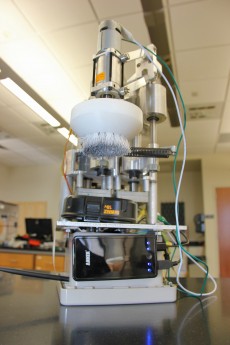Next time you look out the window and see a robot checking your power lines, don’t worry, it’s a safer alternative.
Researchers from the University of Georgia College of Engineering have developed a new robot that may change the way power lines are inspected by making it safer and more cost-effective.
These days, if a power line needs to be expected, human workers need to take extra safety precautions and sometimes even shut off the power before expecting, which can be dangerous and time-consuming.
The new robot, created by Javad Mohammadpour, an assistant professor of electrical engineering, and his team can glide along electrical lines and search for problems or just perform routine maintenance.

The robot, just about the size of a coffee maker, is much lighter than similar devices used by utility companies today.
“This is a tool that’s small enough for a single utility worker to pack in a truck or van and use daily,” said Mohammadpour. “Some of the robots currently in use weigh 200 to 300 pounds while our robot is only 20 to 25 pounds.”
When the wireless robot reaches the line, it uses its spinning brush to clear utility lines of vegetation, bird droppings, and salt deposits that may degrade the line. It also has an on-board camera for close-up inspection by the crew, who can control it via smartphone or computer.
“This is our first prototype, and there are a number of advances we would like to explore, including making the robot more autonomous,” said Mohammadpour. “For example, some decision-making could be made on board. If the robot detects a problem, it could send a signal to the controller instead of requiring a person to monitor the robot in real time.”
The researchers would also like to add GPS to the robot so that it can alert workers of potential proplems and let them know where there’s need for follow up inspections.
In addition, Mohammadpour said the robot could be outfitted with GPS technology. This would allow the robot to geo-tag potential problems along electrical lines, alerting utility workers to the need for follow-up inspections at specific locations.
Take a look at the robot in the video below.
https://vimeo.com/162695211


Comments are closed, but trackbacks and pingbacks are open.